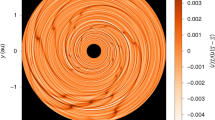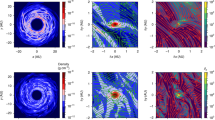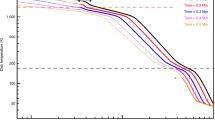Abstract
Planetary systems are born in the disks of gas, dust and rocky fragments that surround newly formed stars. Solid content assembles into ever-larger rocky fragments that eventually become planetary embryos. These then continue their growth by accreting leftover material in the disk. Concurrently, tidal effects in the disk cause a radial drift in the embryo orbits, a process known as migration1,2,3,4. Fast inward migration is predicted by theory for embryos smaller than three to five Earth masses5,6,7. With only inward migration, these embryos can only rarely become giant planets located at Earth's distance from the Sun and beyond8,9, in contrast with observations10. Here we report that asymmetries in the temperature rise associated with accreting infalling material11,12 produce a force (which gives rise to an effect that we call ‘heating torque’) that counteracts inward migration. This provides a channel for the formation of giant planets8 and also explains the strong planet–metallicity correlation found between the incidence of giant planets and the heavy-element abundance of the host stars13,14.
This is a preview of subscription content, access via your institution
Access options
Subscribe to this journal
Receive 51 print issues and online access
$199.00 per year
only $3.90 per issue
Buy this article
- Purchase on Springer Link
- Instant access to full article PDF
Prices may be subject to local taxes which are calculated during checkout



Similar content being viewed by others
References
Goldreich, P. & Tremaine, S. Disk-satellite interactions. Astrophys. J. 241, 425–441 (1980).
Ward, W. R. Protoplanet migration by nebula tides. Icarus 126, 261–281 (1997).
Kley, W. & Nelson, R. P. Planet-disk interaction and orbital evolution. Annu. Rev. Astron. Astrophys. 50, 211–249 (2012).
Baruteau, C. et al. Planet-disc interactions and early evolution of planetary systems. Preprint at http://arxiv.org/abs/1312.4293 (2013).
Paardekooper, S.-J., Baruteau, C. & Kley, W. A torque formula for nonisothermal type I planetary migration—II. Effects of diffusion. Mon. Not. R. Astron. Soc. 410, 293–303 (2011).
Masset, F. S. & Casoli, J. Saturated torque formula for planetary migration in viscous disks with thermal diffusion: recipe for protoplanet population synthesis. Astrophys. J. 723, 1393–1417 (2010).
Tanaka, H., Takeuchi, T. & Ward, W. R. Three-dimensional interaction between a planet and an isothermal gaseous disk. I. Corotation and Lindblad torques and planet migration. Astrophys. J. 565, 1257–1274 (2002).
Levison, H. F., Thommes, E. & Duncan, M. J. Modeling the formation of giant planet cores. I. Evaluating key processes. Astron. J. 139, 1297–1314 (2010).
Cossou, C., Raymond, S. N., Hersant, F. & Pierens, A. Hot super-Earths and giant planet cores from different migration histories. Astron. Astrophys. 569, A56 (2014).
Howard, A. W. Observed properties of extrasolar planets. Science 340, 572–576 (2013).
Pollack, J. B. et al. Formation of the giant planets by concurrent accretion of solids and gas. Icarus 124, 62–85 (1996).
Mordasini, C., Mollière, P., Dittkrist, K.-M., Jin, S. & Alibert, Y. Global models of planet formation and evolution. Preprint at http://arxiv.org/abs/1406.5604 (2014).
Fischer, D. A. & Valenti, J. The planet-metallicity correlation. Astrophys. J. 622, 1102–1117 (2005).
Wang, J. & Fischer, D. A. Revealing a universal planet-metallicity correlation for planets of different solar-type stars. Astron. J. 149, 14 (2015).
Bitsch, B., Crida, A., Morbidelli, A., Kley, W. & Dobbs-Dixon, I. Stellar irradiated discs and implications on migration of embedded planets. I. Equilibrium discs. Astron. Astrophys. 549, A124 (2013).
Jenkins, J. S. et al. in European Physical Journal Web of Conferences Vol. 47, 5001 (2013); http://dx.doi.org/10.1051/epjconf/20134705001.
Hansen, B. M. S. & Murray, N. Testing in situ assembly with the Kepler Planet Candidate Sample. Astrophys. J. 775, 53 (2013).
Chiang, E. & Laughlin, G. The minimum-mass extrasolar nebula: in situ formation of close-in super-Earths. Mon. Not. R. Astron. Soc. 431, 3444–3455 (2013).
Walsh, K. J., Morbidelli, A., Raymond, S. N., O'Brien, D. P. & Mandell, A. M. A low mass for Mars from Jupiter's early gas-driven migration. Nature 475, 206–209 (2011).
Ramsey, J. P. & Dullemond, C. P. Radiation hydrodynamics including irradiation and adaptive mesh refinement with AZEuS. I. Methods. Preprint at http://arxiv.org/abs/1409.3011 (2014).
Hayashi, C., Nakazawa, K. & Nakagawa, Y. in Protostars and Planets II (eds Black, D. C. & Matthews, M. S.) 1100–1153, 1985.
Stone, J. M. & Norman, M. L. ZEUS-2D: A radiation magnetohydrodynamics code for astrophysical flows in two space dimensions. I—The hydrodynamic algorithms and tests. Astrophys. J. Suppl. Ser. 80, 753–790 (1992).
Masset F. FARGO: A fast eulerian transport algorithm for differentially rotating disks. Astron. Astrophys. Suppl. 141, 165–173 (2000).
Szulágyi, J., Morbidelli, A., Crida, A. & Masset, F. Accretion of Jupiter-mass planets in the limit of vanishing viscosity. Astrophys. J. 782, 65 (2014).
Commerçon, B., Debout, V. & Teyssier, R. A fast, robust, and simple implicit method for adaptive time-stepping on adaptive mesh-refinement grids. Astron. Astrophys. 563, A11 (2014).
Crida, A., Baruteau, C., Kley, W. & Masset, F. The dynamical role of the circumplanetary disc in planetary migration. Astron. Astrophys. 502, 679–693 (2009).
Acknowledgements
We thank A. Morbidelli for a critical reading of a first version of this manuscript. P.B.-Ll. thanks CONICET for financial support. This research was supported by UNAM grants PAPIIT IA101113 and IN105313 and by CONACyT grants 178377 and 129343. J.Sz. acknowledges support from the Capital Fund Management's J. P. Aguilar Grant. We also thank U. Amaya Olvera, R. García Carreón and J. Verleyen for their assistance in setting up the GPU cluster on which the calculations presented here have been run.
Author information
Authors and Affiliations
Contributions
P.B.-Ll. performed the numerical simulations and their subsequent reduction. F.M. designed the project and wrote the Methods. G.K. wrote the main paper. J.Sz. provided assistance with the radiative transfer module. All authors contributed to the discussion presented in this manuscript.
Corresponding author
Ethics declarations
Competing interests
The authors declare no competing financial interests.
Extended data figures and tables
Extended Data Figure 1 Exploration of the parameter space.
Heating torque ΓH normalized to the absolute value of the torque of the non-accreting case |ΓNH|, as a function of embryo mass Mp, opacity κ and mass doubling time τ. Whenever one parameter is varying, others have the value of the fiducial run. Mass-doubling times are given in units of years and show that a positive torque results for τ ≲ 60,000 years. The right axis shows the total torque Γ = ΓH + ΓNH, also normalized to |ΓNH|. The horizontal dashed line corresponds to no migration. Source data for this figure are available online.
Rights and permissions
About this article
Cite this article
Benítez-Llambay, P., Masset, F., Koenigsberger, G. et al. Planet heating prevents inward migration of planetary cores. Nature 520, 63–65 (2015). https://doi.org/10.1038/nature14277
Received:
Accepted:
Published:
Issue Date:
DOI: https://doi.org/10.1038/nature14277
This article is cited by
-
Web of resonances and possible path of evolution of the small Uranian satellites
Astrophysics and Space Science (2022)
-
Early terrestrial planet formation by torque-driven convergent migration of planetary embryos
Nature Astronomy (2021)
-
Setting the Stage: Planet Formation and Volatile Delivery
Space Science Reviews (2020)
Comments
By submitting a comment you agree to abide by our Terms and Community Guidelines. If you find something abusive or that does not comply with our terms or guidelines please flag it as inappropriate.



